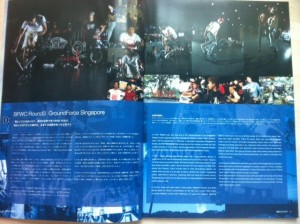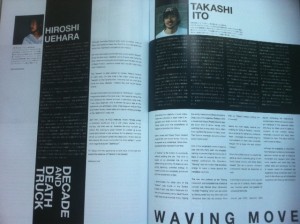Review by Effraim.
It is pretty much a given that every week we see a new amazing flatland edit or a clip come out of Japan. The land of the rising sun is widely recognised as leading the way in flatland. As much as they do that in terms of contests, jams, bmx schools and video edits, we have never seen much in terms of printed media. I recall there was Dig-it magazine in the 90’s, that was almost impossible to get ahold of. With that being said. It was with great pleasure that I was asked to review a new magazine out of Japan, called “Encounter”. The magazine is currently on its 2nd issue.
I hear you already, is it written all in japanese… No, there are english and japanese texts to all the articles in the magazine, all articles are translated!
First impression?
The magazine is very cleanly laid out, full colour magazine, on a really nice glossy paper. Clean cut. Simple design. Perfect binding. Very professional. Gave me the feel of an up market BMX magazine/booklet.
So what’s inside?
Intro – Editor, Yasu “Green G” Takeo writes about the concept of Encounter.
“Recording Challenges, struggling at creation, finding out something through BMX and travelling, a general theme of life is found in it. I believe this point of view would lead our magazine to being timeless”.
Flatland related articles:
The BFWC Groundforce contest in Singapore gets a great double page spread, really nicely laid out collage of photos, Yasu captures the contest well with typically a great photo of Moto with Matthias Dandois pondering his next move after. The text largely focusses on the background going into Groundforce, it was however the text that went into the contest mindset that stuck out for me “Matthias Dandois and Moto Sasaki faced off. Moto’s concentration was unusual. Moto totally mimicked Matthias combo after Matthias’s run gave him pressure. Matthias failed to fight back in his run and Moto pulled off his harder tricks dialled. Matthias was totally stumped. That’s the game.” No one really talks about the psychological in flatland, so I found this although, just a short text, it was great to read.
York Uno and Calvin Tan both have full page photographs on the following page.
Great double page spread “Smile for future” a project supporting the victims of the Tohoku Region Pacific Coast earthquake. Put together by Yohei “Ucchie” Uchino who himself was a victim of the Hanshin earthquake in 1996.
Ucchie teamed up with fellow rider and great friend, Kotaro Tanaka to visit several disaster areas in Tohuku, and joined volunteer works to help support the local community. Personally I found this very moving, and another great side of flatland and bmx, helping others in greater need. I’m sure this article could have taken up the whole page. It is great to see professional riders giving back! Brilliant!
Without a doubt the highlight of the magazine for me, is a seven page article entitled “A Theme and answers”, riders discuss memorable tricks. The article features riders such as Chad Degroot (who has been a massive influence on the japanese flatland scene! Check Baco 7 below this review!), Alain Massabova, Shinichiro Hara, Hiroshi Uehara, Takashi Ito, Hiroya Morisaki, amongst others.
Chad Degroot discusses the “Darkside” – and also the decade, “It was a good session one random day. Then I was falling and didn’t want to put my foot down so it hit the bars and the backend swung up. Almost naturally I jumped to the pegs. After a few tries it was easy and looked cool as hell. It then spawned the front to back and back to front variations. To this day I still do that trick almost every time I ride, it just flows and feels sweet.
Therefore the most memorable trick in my eyes is the Decade over 20 years ago. While the most memorable trick for myself personally is the Darkside.”
Alain Massabova discusses the Time Machine, and it’s origins. “A man named Jesse Puente made history by doing the time machine on the pedals in 1994, he was the man! Thanks to Kevin and Jesse for pushing this trick. We’ve come full circle, a time machine on the pedals is just a like a spinning cherrypicker or pedal picker!”
Shinichiro Hara writes about the whiplash turbine, he recalls how a friend called him from the USA and broke the news Kerry Gatt was doing something similar. he talks about stopping the trick for five years when it became popular. It took him 5 years to realise a different way to do the trick, to make it his own again. I think as flatlanders we can all relate to that moment when your heart sinks, yes somebody already did the move you’ve been working on for so long. Its documented, it’s out there. This case in point, Kerry Gatt, Baco 9.
Hiroshi Uehara of 430 clothing and Hiroya Morisaki discuss the decade, the decade appears to the most popular choice for memorable trick in this article. And you can understand why. “My most memorable and favourite trick would be the “decade”. It was the first trick I mastered. As my friends were trying this trick, I knew how strong the accomplishment felt after you pull it. Eager to learn, I swore to myself that I wouldn’t stop riding until I mastered it.
Hiroya recalls “I was in a football club and had trainings after school. I would later practice tricks under the lights at the car park of a local electrical shop. With lots of injuries on my legs, I practiced everyday and I mastered the “decade” in 3 weeks. The feeling of achievement was something I had never experienced. One of the motivations when I try new tricks is this feeling of achievement. Yes I did it, but strangely I did not know the name of this trick, so I named it “CC Lemon” after the TV commercial.”
Takashi Ito has deep roots in the growth of flatland in Japan. Unlike everyone else, Takashi talks about the “Waving move”, “The rider who polished up the ” and “waving movement” and completed it as a historical concept was Yanmar (Ryoji Yamamoto). He tried “Paddling” which was also similar to waving earlier than any other riders and integrated them into his combos. From then on, Flatland started evolving into a “new era”.
Takuma Kawamura Izu Road trip through the picturesque Izu peninsula, has 6 pages which relates back to Yasu’s intro…”Recording Challenges, struggling at creation, finding out something through BMX and travelling, a general theme of life is found in it. I believe this point of view would lead our magazine to being timeless”.
Takuma writes “During travelling, “gut feeling is the key. Right or left, to stop or go, to talk or leave, you always have to choose. This sense will probably be more developed the more you are on the road. I want to encourage all of you who hesitate to set off. Why don’t you develop your own “travel sense?”
Keita “Kane” Uchino has a full page bio to round up the flatland coverage in issue 2 of Encounter magazine.
As with all reviews on FM. I concerntrated on the flatland side of things, there is of course much more content besides. It is great to see a legit magazine come out of Japan. What is even better is the magazine is available over here! I hope to see more issues in the future! This is definitely one for the collectors out there!
Hit the links for more information on how to get hold of Encounter Magazine.
http://fingerprintdistribution.bigcartel.com/
http://fingerprintdistribution.bigcartel.com/product/encounter-magazine-issue-2




Wow, this look really cool! I’m glad we’ve got fingerprint distribution.
I didn’t know that japanese riders called pumping “waving” or “paddling”.
Look forward to reading this!
Yep I never knew that either Chris! The beauty of print!
They didn’t paddling is similar to waving is what it says ,pumping was the K’s creation.